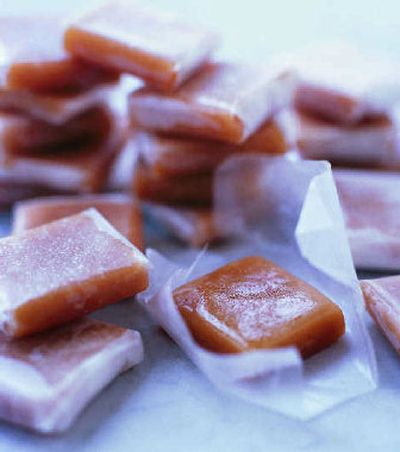Unforgettable experience

Sinking your teeth into a soft, chewy caramel is an unforgettable experience.
Its sweet, buttery sensation lingering with each bite, this amber-colored confection is a treat worth sharing. Individually wrapped in twists of waxed paper or colorful cellophane and stacked in festive tins or boxes, homemade caramels are perfect for holiday gift giving.
With this delicious recipe, the proper equipment, and just about an hour to devote to the task, you’ll be able to produce enough caramels for several fortunate recipients. Turning sugar, cream and evaporated milk into rich, golden caramel involves very little candy-making skill.
If you can boil water and stir liquid, you can make soft caramels.
The most essential part of the process is cooking the ingredients to the correct temperature, and this takes a bit of patience. When making caramels, the timing is very important. If the ingredients are undercooked, even by one or two degrees, the caramels will be too soft and will not have the proper flavor. If the ingredients are overcooked, the candies will be too firm.
These soft caramels are cooked to 238 degrees. It will take a while to reach the required temperature (from 30 to 40 minutes), but the result is worth every minute.
Before making the caramels, be sure to read the recipe thoroughly to familiarize yourself with the method and to learn what ingredients and equipment you’ll need. Our recipe uses standard candy-making equipment: a good-quality candy thermometer to ensure an accurate reading, a 4-quart heavy-bottomed saucepan to prevent scorching and to accommodate excessive boiling, and a heat-resistant rubber spatula to withstand high temperatures.
You may want to test the accuracy of your thermometer since caramels rely so heavily on temperature. To do so, place it inside a pot of boiling water: It should read 212 degrees if properly calibrated.
Peter Greweling, professor in baking and pastry arts at The Culinary Institute of America, offers a few additional tips to guarantee caramel-making success:
• Cook ingredients over moderate heat to fully develop the flavor and color of the caramel.
• Stir constantly, using a figure-8 motion to keep the bottom of the pan clean and to prevent the caramel from scorching.
• For the most accurate temperature readings, always read the thermometer at eye level.
• When pouring the caramel into the prepared pan, avoid scraping the bottom of the saucepan, as this mixture has cooked to a higher temperature and will cause hard spots to form in the caramel.
• Allow caramel to cool completely at room temperature before cutting into desired shapes.
• Store caramels in an airtight container between sheets of waxed paper. Leave space between each caramel to keep them from sticking together. The candies will retain their quality for several weeks at room temperature.
• When presenting caramels as holiday gifts, wrap each piece individually in pre-cut candy wrappers, waxed paper or cellophane. You can buy candy wrappers and boxes or tins at craft shops and stores that sell cake- and candy-making supplies.
You can find additional gift ideas and other confectionary recipes in The Culinary Institute of America’s “Baking At Home With The Culinary Institute of America” cookbook (Wiley, 2004, $40).
Soft Caramels
Recipe from The Culinary Institute of America’s “Baking At Home with The Culinary Institute of America” cookbook (Wiley, 2004, $40)
Flourless cooking spray for greasing
1 3/4 cups sugar
12-ounce can evaporated milk
1/2 vanilla bean, split lengthwise
2/3 cup heavy cream
1 cup light corn syrup
1 tablespoon unsalted butter
1 1/2 teaspoon salt
Lightly coat an 8-inch square baking pan with cooking spray. Cut two 8-by-16-inch rectangles of parchment paper. Lay one strip of the parchment in the baking pan, pressing it to the bottom and sides. Lightly coat the parchment with cooking spray. Lay the second parchment rectangle across the pan in the opposite direction to form a cross. Press the parchment to the bottom and sides of the pan and lightly coat with cooking spray. You should have a few inches of paper hanging over each side of the pan.
Combine the sugar, evaporated milk, vanilla bean and cream in a 4-quart heavy-bottomed saucepan. Bring the mixture to a boil over medium heat, stirring constantly. Once the mixture begins to boil, add the corn syrup and continue to stir. Cook the caramel until it reaches 230 degrees Fahrenheit on a candy thermometer, and then add the butter and the salt. Continue cooking and stirring until you reach 238 degrees Fahrenheit; immediately pour into the prepared pan – do not scrape the caramel from the bottom of the pan. Remove the vanilla bean with the tip of a knife.
Cool to room temperature. Using the excess parchment paper as handles, lift the caramel slab from the pan and place onto a cutting board. Cut the caramel into squares or desired shapes with a large sharp knife. If the caramel sticks to the knife when cutting, lightly coat the blade with vegetable oil.
Yield: 64 (1-inch) caramels.
Nutrition information per caramel (.5-ounce): 45 calories, .5 grams fat, 0 grams protein, 10 grams carbohydrate, no cholesterol, 30 milligrams sodium, no dietary fiber.